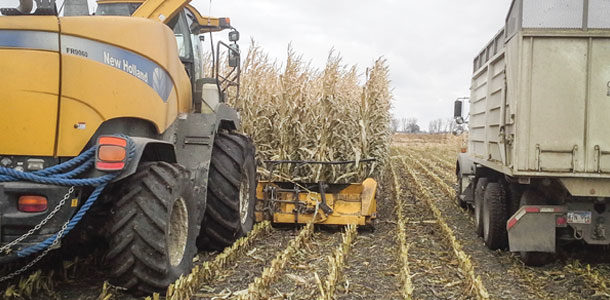Opp owns a custom silage chopping business he is buying from his father. His father chopped about 2,000 acres for local farmers, originally with the intent to help make the payments for the chopper.
Since Opp took over the business three years ago, he has expanded across South Dakota and into North Dakota, and now chops 8,000 acres of corn, cereals and alfalfa per year.
“I am one of those who do not stop climbing the ladder of success, even when I reach the top. I just build it taller. While building from 2,000 acres to 8,000 acres in three years is nice, it’s still not where I want to be.
I want to be larger with more machines and a well-known name,” Opp says.
Opp’s inspiration comes from his grandfather, Theodore Opp, who was a well-known, successful Hereford breeder. When he was still fairly young, Theodore lost the sight in one of his eyes.
He was told that he wouldn’t be able to keep farming with one eye, but he didn’t retire until he developed glaucoma in his remaining eye at the age of 91.
Opp calls his grandfather “a progressive farmer” and wants to follow in his footsteps.
“Being the third generation on the farm is tough, and I work as hard for everything I have as my grandpa did in the early 1900s for everything he has now,” Opp says.
One of his greatest challenges is the size of the acreages he chops. His largest customer has him chop 500 acres, but most of his customers have him chop around 100 acres.
With smaller acreages, it is more difficult to be efficient, and he ends up spending a lot of time going between jobs. This makes it difficult to expand and difficult to get to all his customers when they need him.
“It really is tough with the smaller customer base that I have. And trying to keep 50 customers happy – it’s a tough deal. But I’ve learned that the small customers definitely need help as much as the big guys do,” Opp says.
But Opp is open with his customers about his difficulties, and they are willing to work with him to increase efficiency and keep costs down.
Some are planting in larger, square fields and making sure the field is closer to the bunker. Since he usually chops smaller acreages, Opp uses a 25-foot head on his harvester because he feels it helps him be more efficient.
Another difficulty Opp faces is finding labor to drive the trucks.
“Aside from being able to find seasonal labor, nobody wants to work 16-hour to 18-hour days. It seems as though it does not matter how bad a person needs money, they do not want to work for it and do not want to work more than a 40-hour, maybe 50-hour work week,” Opp says.
But these difficulties aren’t stopping him from looking forward to expanding even more. This year, Opp is partnering up with a friend who also has a chopper so that together they can take on bigger jobs and increase their efficiency.
“I’d like to expand to Kansas and farther south to make the season longer so we can justify hiring employees all summer long. The way it is right now, most of our business comes in the fall,” Opp says.
While expansion and success are keen on Opp’s mind, his main goal is still customer satisfaction. He always runs the chopper himself to make sure the job is done right.
He brings along his own tractor to ensure the silage pile is packed properly. And he keeps a moisture and yield monitor in his chopper so he can tell his customer just what is going on during harvest.
Even after the harvest is over, he continues to work with the customer to ensure the silage remains the best quality.
During the winter, Opp visits each customer’s silage pile at least once. “I make sure I’m doing what I feel is a satisfactory job, and I make sure they’re happy.
Most of my customers are beef customers, and they’re not real picky about the quality of the silage, but I still want to give them the best that I can,” Opp says.
A feed nutritionist and a forage specialist usually accompany Opp on his visits to help him know what to do to improve his work. Opp often encourages customers to cover their piles, use inoculants and switch to more cost-effective feeds.
“Every year I get more and more guys who are covering their piles. Last year, I’d say that 80 percent of my guys put inoculant on. I’ve got a few customers to switch to oat-pea or triticale-pea haylage as an alternative feed. And they’re all very happy with the results,” Opp says.
As Opp puts it, when farmers are happy, they talk about it. And that is how Opp hopes to continue to expand his market.
“My forage specialist always comments on how I am the only person who chops that cares about the customer being happy, not just satisfied, with the outcome of my work. There is no greater pride than shaking hands with happy customers when I see them,” Opp says. FG
Alisa Anderson Raty is a freelancer based in Idaho.
PHOTOS
PHOTO 1:Custom harvester Matt Opp carries a moisture and yield monitor in his chopper to gauge silage quality and quantity.










